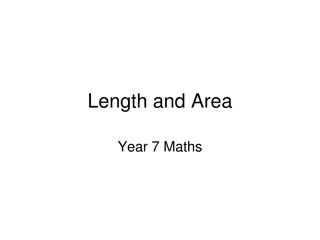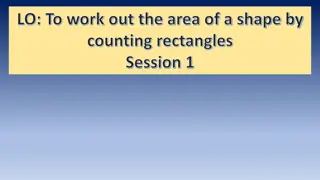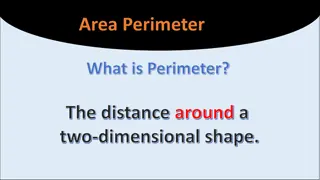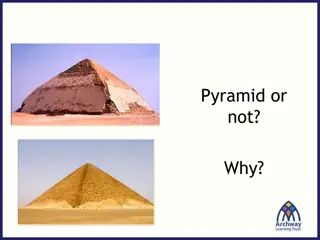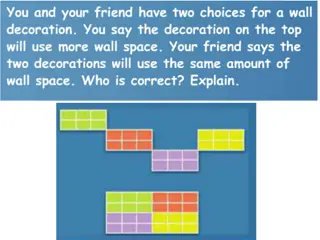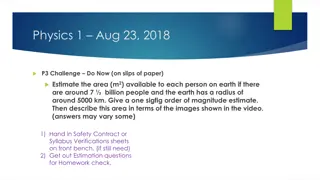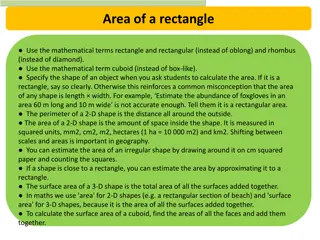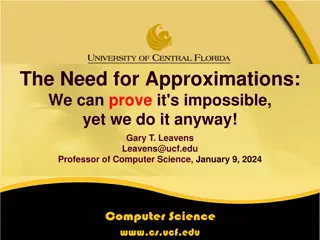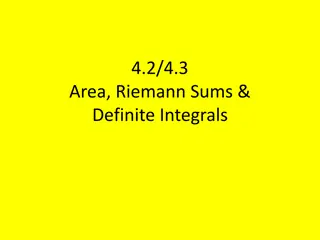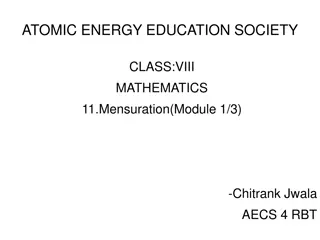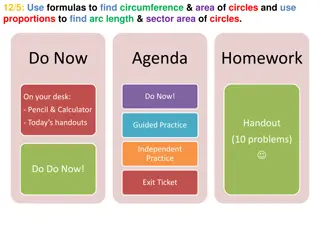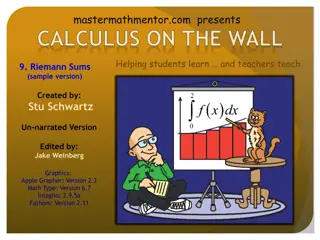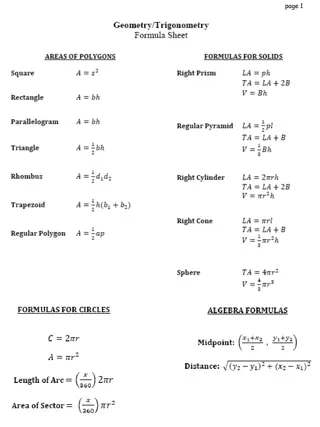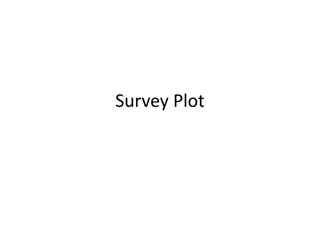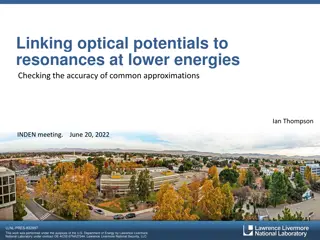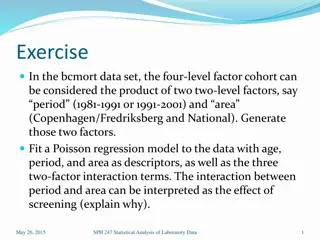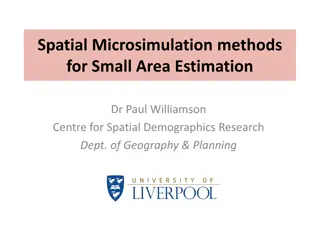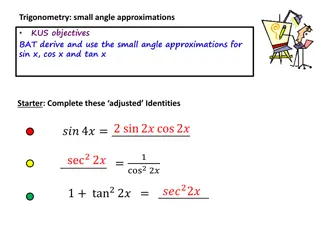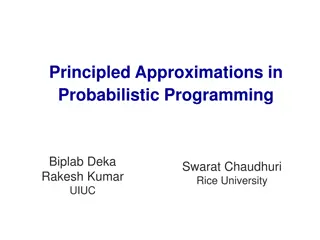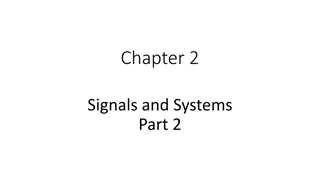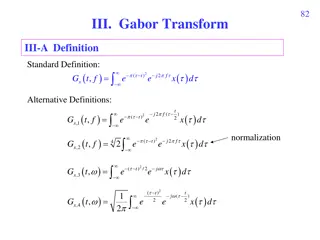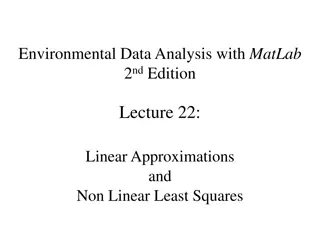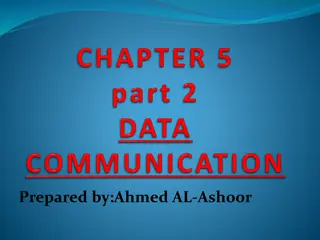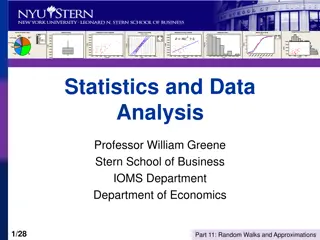Surface Area and Volume in Geometry
Gain insights into calculating surface area and volume of geometric shapes, specifically focusing on rectangular prisms. Learn how to find surface area and lateral area using formulas, and explore examples illustrating these calculations step by step with images.
2 views • 57 slides
Length and Area Concepts in Year 7 Maths
Delve into the world of measurements, accuracy limits, and area calculations in Year 7 Math. Learn about the accuracy of measurements, limits of accuracy, calculating the area of shapes, converting units of area, and investigating the area of triangles. Explore practical examples and understand the
1 views • 20 slides
Area of Shapes through Rectangles
This educational session focuses on learning to calculate the area of shapes by counting rectangles. It covers concepts of perimeter and area, providing visual examples and challenges to reinforce understanding. Students will engage in activities to practice determining the area of various shapes by
2 views • 35 slides
Area and Perimeter in Geometry
Area and perimeter are important concepts in geometry. Area refers to the space inside a two-dimensional shape, while perimeter is the distance around the shape. Formulas and examples for calculating perimeter and area of rectangles and squares are provided in the content. Watch the linked videos fo
1 views • 13 slides
Perimeter and Area in Math
Explore the concepts of perimeter and area through simple explanations and visual examples. Learn how to calculate the perimeter and area of shapes like squares and rectangles with real-world applications in farming. Discover how farmers use perimeter to determine fence needs and area to plan tree p
1 views • 8 slides
Surface Area in Mathematics
Delve into the concept of surface area as an essential mathematical topic, understanding its significance in everyday life and its application in various 3D shapes. Learn how to calculate surface area for different space figures like prisms and pyramids through step-by-step methods. Engage with esse
7 views • 21 slides
Pyramid Geometry for Surface Area Calculations
Delve into the concept of surface area calculations for pyramids, ranging from identifying fake pyramids to determining the surface area of iconic structures like the Great Pyramid. Learn about the essential information needed, such as base length and slant height, to derive accurate measurements. D
0 views • 32 slides
Geometry Concepts: Perimeter, Circumference, and Area
Explore the fundamental concepts of perimeter, circumference, and area in geometry through a series of problems and visuals. Understand how to calculate the perimeter of a rectangle, find the circumference of a circle, determine area in the coordinate plane, and solve for area of rectangular and irr
1 views • 13 slides
Learning-Based Low-Rank Approximations and Linear Sketches
Exploring learning-based low-rank approximations and linear sketches in matrices, including techniques like dimensionality reduction, regression, and streaming algorithms. Discusses the use of random matrices, sparse matrices, and the concept of low-rank approximation through singular value decompos
0 views • 13 slides
Solving for Area Between Parabolas
Determine the bounded area between two parabolas by finding their intersection points and calculating the area enclosed. Follow a systematic approach independent of constants, consider translations to avoid negative areas, and evaluate the area accurately by tracking the curve shift. The mathematica
0 views • 32 slides
Estimating Available Area for Each Person on Earth
Consider estimating the area available per person on Earth based on a population of around 7 billion and the Earth's radius of approximately 5000 km using one significant figure. Relate this area to concepts discussed in the provided images, such as uncertainties in physics, accuracy, precision, and
0 views • 13 slides
Area and Surface Area in Mathematics
This informative content explains the concepts of area and surface area in mathematics. It emphasizes the distinction between rectangles, rectangular areas, cuboids, and rhombuses to promote accurate calculations. The importance of scale shifts, estimating irregular shapes, and calculating perimeter
0 views • 6 slides
Sequential Decision Analytics Framework Overview
This content discusses a unified framework for sequential decision analytics presented at Olin Business School, University of Washington. Topics include guidelines for choosing policies, policy function approximations, cost function approximations, value function approximations, and direct lookahead
0 views • 11 slides
The Need for Approximations in Computer Science
Exploring the concept of approximations in computer science, despite the inherent challenges in proving them, as discussed by Professor Gary T. Leavens. The content covers the background of problems and algorithms, defining effective procedures through examples and intriguing programs. Delve into th
1 views • 34 slides
Area, Riemann Sums, and Definite Integrals
Antiderivatives are utilized to find area under curves, where Riemann Sums are employed for approximations. The process involves dividing intervals into rectangles for both approximate and exact area calculations. Definite integrals provide specific, finite values representing total displacement, wi
0 views • 8 slides
The High Cost of Building in the Bay Area
Multiple factors such as land, materials, labor, fees, financing, consultants, and tax regulations contribute to the high cost of building in the Bay Area. Local policies, state priorities, federal regulations, and market forces also play a role. As a result, construction projects in the Bay Area ca
1 views • 6 slides
Pressure: Force, Area, and Application
Pressure is a fundamental concept in physics, defined as the force acting perpendicular to an object's surface area. This article explores what pressure is, how to calculate it, and provides examples of its application in everyday scenarios. Learn about the relationship between force and area, the f
1 views • 16 slides
Perimeter, Area, and Mensuration in Mathematics
In this educational module, we delve into the concepts of perimeter and area of closed plane figures like triangles, rectangles, circles, and quadrilaterals. We also discuss surface area and solve problems related to these geometric concepts. Through examples and visuals, students learn how to calcu
1 views • 11 slides
Circles: Formulas for Circumference, Area, and Proportions for Arc Length and Sector Area
Learn how to calculate the circumference and area of circles using formulas, and use proportions to find arc length and sector area. Master the concepts through examples and practical applications in geometry.
1 views • 18 slides
Strategy-Proof Voting: Approximations and Possibilities
Explore the concept of approximately strategy-proof voting through models and constructions, aiming to prevent manipulation while ensuring fair outcomes. Discuss the challenges and potential methods to circumvent manipulations based on Gibbard-Satterthwaite theorems. Delve into defining approximatio
1 views • 11 slides
Riemann Sums and Area Approximations in Calculus
Explore the concepts of Riemann sums, different types of approximations like left, right, and midpoint sums, trapezoidal rule, and interpreting area in real-life scenarios with examples. Learn how to apply these methods to approximate irregular areas and calculate distances and average speeds. Dive
0 views • 6 slides
Geometry: Lateral Area, Total Area, and Volume of Right Prisms
This educational content covers the concepts of lateral area, total area, and volume calculation for right prisms, specifically focusing on rectangular, triangular, trapezoidal, and hexagonal right prisms. It includes detailed explanations, formulas, and examples to help you grasp these geometric pr
1 views • 22 slides
Calculating Polygon Area and Trapezium Area with Known Coordinates
The content above guides you on finding the exact area of a polygon by calculating the areas of individual triangles within it. It also demonstrates how to list coordinates in a spreadsheet, calculate the area of trapeziums formed by pairs of coordinates, and sum their areas to determine the total a
0 views • 28 slides
Optical Potentials and Resonances at Lower Energies
Investigating the accuracy of common approximations in linking optical potentials to resonances at lower energies. The study focuses on neutron reactions with 14N as a test case, transitioning from R-matrix theory to Hauser-Feshbach models and evaluating known levels and level densities. Key topics
0 views • 22 slides
Poisson Regression Model with Age, Period, and Area Descriptors
The four-level factor cohort in the bcmort data set can be viewed as a combination of two two-level factors - period (1981-1991 or 1991-2001) and area (Copenhagen/Frederiksberg and National). This exercise involves generating these two factors, fitting a Poisson regression model to the data with age
0 views • 18 slides
Perimeter and Area in Mathematics
In this chapter, students will gain a clear understanding of the concepts of perimeter and area of closed figures. They will learn to differentiate between perimeter and area and apply relevant formulas to solve various problems. The practical applications of perimeter and area in daily life scenari
0 views • 34 slides
Approximation Employed in Spontaneous Emission Theory / D.F. Walls and C.W. Gardiner (Physics Letters 41A (1972))
Examining the approximations utilized in Spontaneous Emission Theory by Walls and Gardiner in 1972. Discusses the motivation, Hamiltonian derivation, and comparisons between R.W.A and the Ladder approximations.
0 views • 24 slides
Systematic Observation on Rear Leakage Correction
Different behavior observed between Data and Monte Carlo simulations in terms of rear leakage correction, with details on the lack of dependence on energy in initial approximations, comparisons between TB and MC data, fits and approximations at different energy levels, and systematic analysis of Cle
0 views • 11 slides
Spatial Microsimulation Methods for Small Area Estimation
Spatial microsimulation methods, as discussed by Dr. Paul Williamson, involve direct survey estimation, conventional small area estimation (SAE) approaches, and spatial microsimulation techniques. The process includes recalibrating survey data to meet local area constraints, such as ethnic and age d
0 views • 29 slides
Trigonometry Small Angle Approximations and Identities
Delve into the use of small angle approximations in trigonometry, deriving and applying identities for sine, cosine, and tangent functions. Understand the significance of small angles in accurate calculations and explore the practical applications in physics fields. Discover adjusted trigonometric i
0 views • 13 slides
Algorithms for Big Data: Special Topics on CSCE 689
This course covers advanced algorithms for handling big data, focusing on topics such as Euclidean space, CountSketch, ?2 estimation, moment estimation, Johnson-Lindenstrauss lemma, and algorithm implementation. Dive into the intricacies of Euclidean space, distance functions, heavy-hitters problems
0 views • 35 slides
Principled Approximations in Probabilistic Programming and Hardware Fault Tolerance
Explore the world of probabilistic programming with advancements in principled approximations. Delve into robustness to hardware faults in sampler clustering using DPMM. Discover the concept of approximating compilers and the implementation of probabilistic programs. This collection covers a range o
0 views • 12 slides
Signals and Systems: Fourier Series, Square Wave Approximations, and Orthogonality
Explore the concepts of Fourier series, square wave approximations, and signal orthogonality in the context of signals and systems. Learn how square waves, trigonometric series, and exponential decay can be represented and analyzed using mathematical approaches. Understand the significance of signal
0 views • 16 slides
Gabor Transform: Definitions, Approximations, and Applications
Explore the Gabor Transform, including its definitions, approximations, and applications in signal processing and time-frequency analysis. Learn about the Gaussian function, uncertainty principle, and more in this comprehensive guide.
0 views • 32 slides
Environmental Data Analysis: Linear Approximations and Nonlinear Least Squares
Explore the application of linear approximations to error estimation and least squares in environmental data analysis. Learn how to make linear approximations of nonlinear functions and apply them effectively. Dive into polynomial approximations and Taylor series to enhance your understanding of dat
0 views • 53 slides
Understanding Local Area Networks (LAN) and Wide Area Networks (WAN)
Explore the concept of Local Area Networks (LAN) and Wide Area Networks (WAN) in computer networking. Learn about the differences, benefits, and applications of LAN and WAN technologies. Discover how LANs connect devices within a limited area, while WANs connect computers over large geographical dis
0 views • 22 slides
Effective Environmental Data Analysis Techniques
Explore advanced methods in environmental data analysis using MATLAB or Python, with topics ranging from linear approximations to hypothesis testing. Gain insights into making linear approximations of non-linear functions, error estimation, and applying least squares in data analysis. Delve into pol
0 views • 40 slides
Exploring JPEG Image Approximations and Outer Product Calculations
Dive into the world of JPEG image approximations with 8x8 pixel blocks and explore outer product calculations within the images for data analysis. Learn about different levels of approximation and how they affect the final image quality.
0 views • 32 slides
Exploring Mathematical Approximations and Artistic Ratios
Uncover the world of mathematical approximations and artistic ratios through images and explanations, including the Vitruvian Man, the Golden Rectangle, and more. Dive into mathematical concepts and their visual representation, alongside insights into order approximations and first-order approximati
0 views • 25 slides
Understanding Binomial Probability Approximations in Data Analysis
Explore how normal approximations are used to estimate binomial probabilities in data analysis. Learn about the process of converting discrete probabilities to continuous distributions for accurate predictions in statistical modeling.
0 views • 28 slides

